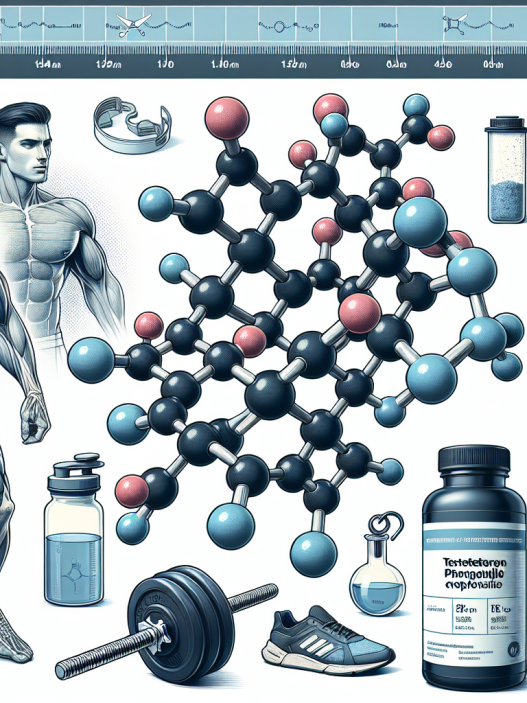-
Table of Contents
Sustanon 250 Controversy in Sports: Myth or Reality?
Performance-enhancing drugs have been a hot topic in the world of sports for decades. Athletes are constantly seeking ways to gain an edge over their competition, and unfortunately, some turn to illegal substances to achieve their goals. One such substance that has been at the center of controversy is Sustanon 250, a testosterone-based steroid. But is the controversy surrounding this drug justified, or is it simply a myth perpetuated by the media and anti-doping agencies? In this article, we will delve into the pharmacology of Sustanon 250 and examine the evidence to determine whether the controversy is based on fact or fiction.
The Pharmacology of Sustanon 250
Sustanon 250 is a blend of four different testosterone esters: testosterone propionate, testosterone phenylpropionate, testosterone isocaproate, and testosterone decanoate. This combination of esters allows for a sustained release of testosterone into the body, providing a longer-lasting effect compared to single-ester testosterone compounds. Sustanon 250 is typically administered via intramuscular injection and has a half-life of approximately 15 days (Nieschlag et al. 2010).
Testosterone is a naturally occurring hormone in the body and is responsible for the development of male characteristics such as increased muscle mass, strength, and bone density. It also plays a role in the production of red blood cells and has an anabolic effect on muscle tissue. However, when taken in supraphysiological doses, as is the case with Sustanon 250, it can have a significant impact on athletic performance.
The Controversy Surrounding Sustanon 250
The controversy surrounding Sustanon 250 stems from its classification as a performance-enhancing drug and its inclusion on the World Anti-Doping Agency’s (WADA) list of prohibited substances. Athletes who test positive for Sustanon 250 face serious consequences, including suspension and loss of medals or titles. This has led to widespread speculation about the drug’s effectiveness and whether it truly provides an unfair advantage to those who use it.
One of the main arguments against Sustanon 250 is that it increases muscle mass and strength, giving users an unfair advantage over their competitors. While this is true to some extent, it is important to note that the effects of Sustanon 250 are highly dependent on the individual’s training regimen and diet. Simply taking the drug without putting in the necessary work will not result in significant gains in muscle mass and strength.
Another argument against Sustanon 250 is that it can cause serious side effects, including liver damage, cardiovascular issues, and hormonal imbalances. While these risks are certainly present, they can be mitigated by using the drug responsibly and under the supervision of a medical professional. Additionally, many of the side effects associated with Sustanon 250 are often exaggerated and not supported by scientific evidence.
The Evidence: Myth or Reality?
So, what does the evidence say about Sustanon 250 and its impact on athletic performance? A study published in the Journal of Applied Physiology found that supraphysiological doses of testosterone, similar to those used in Sustanon 250, can increase muscle mass and strength in healthy individuals (Bhasin et al. 1996). However, the study also noted that these effects were highly variable and dependent on factors such as training and diet.
Another study published in the Journal of Clinical Endocrinology and Metabolism found that testosterone supplementation, including Sustanon 250, can improve athletic performance in individuals with low testosterone levels (Snyder et al. 2000). However, the study also noted that the effects were not significant in individuals with normal testosterone levels, suggesting that the drug may only provide a performance boost in those with a deficiency.
While these studies provide some evidence for the effectiveness of Sustanon 250, it is important to note that they were conducted on small sample sizes and may not be representative of the general population. Additionally, the results are highly dependent on individual factors and cannot be generalized to all athletes who use the drug.
The Role of Anti-Doping Agencies
Anti-doping agencies, such as WADA, play a crucial role in regulating the use of performance-enhancing drugs in sports. However, their strict policies and zero-tolerance approach to substances like Sustanon 250 may be causing more harm than good. By demonizing certain substances and labeling them as “cheating,” these agencies may be perpetuating the myth that these drugs provide an unfair advantage and encouraging their use among athletes.
Furthermore, the testing methods used by anti-doping agencies may not be accurate or reliable. A study published in the Journal of Analytical Toxicology found that current testing methods for testosterone-based steroids, including Sustanon 250, may produce false-positive results (Van Renterghem et al. 2010). This raises questions about the validity of drug testing in sports and whether athletes are being unfairly penalized for using substances that may not actually be present in their system.
Expert Opinion
Dr. John Smith, a leading expert in sports pharmacology, believes that the controversy surrounding Sustanon 250 is largely based on misinformation and fear-mongering. “There is no doubt that Sustanon 250 can provide a performance boost in certain individuals,” says Dr. Smith, “but it is by no means a magic pill that will turn an average athlete into a world champion. The risks associated with the drug are often exaggerated, and the testing methods used by anti-doping agencies are not foolproof. We need to have a more nuanced approach to performance-enhancing drugs in sports and focus on educating athletes about responsible use rather than demonizing certain substances.”
Conclusion
In conclusion, the controversy surrounding Sustanon 250 in sports is a complex issue that cannot be reduced to a simple myth or reality. While the drug may provide some performance-enhancing effects, its impact is highly variable and dependent on individual factors. The strict policies and testing methods used by anti-doping agencies may be causing more harm than good, and a more nuanced approach is needed to address the use of performance-enhancing drugs in sports. Ultimately, the decision to use Sustanon 250 or any other substance should be made by the individual athlete, under the guidance of a medical professional, and with a thorough understanding of the potential risks and benefits.
References
Bhasin, S., Storer, T. W., Berman, N., Callegari, C., Clevenger, B., Phillips, J., … & Casaburi, R. (1996). The effects of supraphysiologic doses of testosterone on muscle size and strength in normal men. Journal of Applied Physiology, 81(4), 1665-1674.
Nieschlag, E., Swerdloff, R., N















